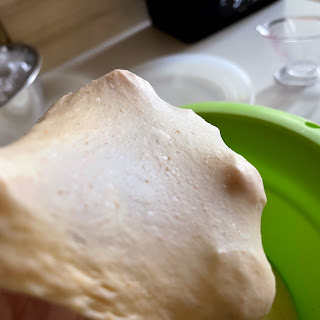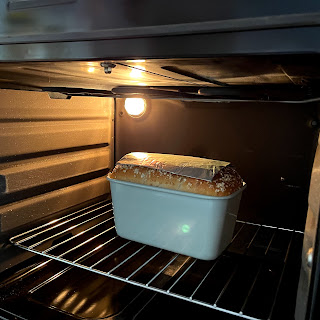I always like to try out different ingredients in my bread baking. When I bought home a small carton of oats & quinoa soy milk (less sugar), I started to work on an oat bread recipe. Added honey, whipping cream, and oatmeal to the crust to match the "oats" theme of this bread.
If you like heavy, dense, springy, yet soft bread, I believe you would enjoy this bread 😍😋
Yield: one loaf of bread
Pan size: 21x13x10 cm Jamie Oliver 1.5L bread pan
Raw dough weight: 649g
Baking temperature: Preheat oven to 190℃, lower rack, bake at 180℃ for 15 minutes, reduce to 170℃ for 15 minutes, turn off oven and continue to bake for 5 minutes. Tent the crust with aluminum foil at the last 7 minutes of baking.
Sweet Stiff Levain (SSL)
Ingredients
40g cool boiled water
15g raw sugar
20g natural yeast, 100% hydration*
80g unbleached bread flour
* 20g natural yeast can be replaced by 10g bread flour + 10g water + 1/8 tsp instant dry yeast
Let the sweet stiff levain stands in room temperature for about 8 hours, or triple in volume, before adding to dough.
Qats & Quinoa Soy Milk Dough
Ingredient
A
200g bread flour
35g spelt flour/plain flour
40g raw sugar
1g instant dry yeast
Pinch vanillin powder, optional
B
150~155g sweet stiff levain
20g multigrain soy pulp *, optional
20g beaten egg
120g oats & quinoa soy milk
30g whipping cream, cold
30g water, cold (to be added depending on dough condition)
C
4g low-sodium fine salt
D
20g unsalted butter, softened
* multigrain soy pulp can be replaced by about 10g milk. Multigrain soy pulp was made up of organic soy beans, almonds, red kidney beans, black beans, split green peas, walnut, pumpkin seeds, mung beans and pandan leaf.
Toppings
2g whipping cream
4g honey
8g instant oatmeal
Directions
Knead the dough following your preferred method till reaching window pane.
1. Mix Ingredient A in a mixing bowl.
3. Knead the dough using an electric hand mixer fitted with a pair of dough hooks till the dough is smoother. Knead in Ingredient C.
4. Knead in Ingredient D,
till the dough is smoother and a bit glossy.
5. Perform about 100 to 200 sets of "slapping and folding" till the dough is elastic (the dough can stretch to about 30 cm without breaking).
6. Shape into a ball
Store the dough in the fridge for about 12 to 16 hours, or overnight to undergo cold fermentation.
My fridge temperature is about 4℃.
7. On the next day, remove the outer plastic bag, invert the dough, and let it thaw in room temperature for about 2 hours.
8. Turn out the dough onto a floured work top. Deflate the dough, divide into 3 portions, and shape into 3 balls. Cover with an inverted mixing bowl, and rest for 15 minutes.
8. Roll out the dough to about 1 cm thick.
Flip over the dough, and fold in the two wings, overlapping each other.
Roll flat to achieve an even thickness. Finally, roll up like a swiss roll.
End of 105-minute second proofing, or till the dough almost reaching the rim of the pan👇
10. Bake at 180℃ for 15 minutes, reduce to 170℃ for 15 minutes, turn off oven and continue to bake for 5 minutes
Tent the crust with aluminum foil at the last 7 minutes of baking, or when the crust has browned before the baking ends,
11. After the bread has completely cooled down, cut and enjoy 🍞 😋















































































